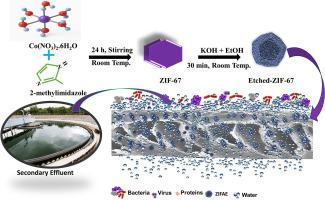Development of alkali-etched ZIF-67 metal-organic framework composite incorporated PVDF UF membranes for efficient wastewater treatment
IF 6.3
3区 工程技术
Q1 ENGINEERING, CHEMICAL
Journal of the Taiwan Institute of Chemical Engineers
Pub Date : 2025-10-04
DOI:10.1016/j.jtice.2025.106424
引用次数: 0
Abstract
Metal-organic framework (MOF)-integrated polyvinylidene fluoride (PVDF) membranes provide a viable approach for advanced water treatment as they exhibit improved hydrophilicity and permeability, as well as antifouling characteristics. PVDF-based UF (ultrafiltration) selective membranes were modified with (zeolitic imidazolate framework) ZIF and ZIFAE (alkali-etched zeolitic imidazolate framework) MOFs in this study. Incorporating ZIFAE MOF membranes demonstrated substantially lowered contact angle, enhanced porosity, and improved flux than ZIF and PVDF membranes. Among them, the pure water flux (PWF) and bovine serum albumin (BSA) rejection of ZIFAE2 were as high as 951 ± 11 L·m⁻²·h⁻¹ and 99 ± 0.5 %, respectively. Cross-sectional and top-surface SEM images confirmed that the ZIFAE membranes showed increased pore density and uniform nanoparticle distribution, which resulted in their better hydrophilicity due to the hydroxyl (-OH) and amino (-NH) functional groups. Results of secondary effluent filtration evaluations indicated less fouling resistance and a more extended operational lifespan of the ZIFAE2 membrane. Such benefits establish ZIFAE-modified membranes as sustainable, real-world, and efficient candidates for wastewater treatment and compact alternatives to traditional tertiary treatment technologies.

碱蚀ZIF-67金属-有机骨架复合材料PVDF - UF膜的研制及其废水高效处理
金属-有机骨架(MOF)-集成聚偏氟乙烯(PVDF)膜具有更好的亲水性和渗透性,以及防污特性,为高级水处理提供了可行的方法。采用(沸石-咪唑酸框架)ZIF和(碱蚀刻沸石-咪唑酸框架)mof对pvdf基超滤选择性膜进行改性。与ZIF和PVDF膜相比,加入ZIFAE MOF膜的接触角大大降低,孔隙率提高,通量提高。其中,ZIFAE2的纯水通量(PWF)和牛血清白蛋白(BSA)排斥度分别高达951±11 L·m⁻²·h⁻¹和99±0.5%。横截面和顶表面SEM图像证实,ZIFAE膜的孔密度增加,纳米颗粒分布均匀,由于羟基(-OH)和氨基(-NH)官能团的存在,ZIFAE膜具有更好的亲水性。二级出水过滤评价结果表明,ZIFAE2膜的抗污性能较低,使用寿命较长。这些优点使zifae改性膜成为可持续的、真实的、高效的废水处理候选材料,也是传统三级处理技术的紧凑替代品。
本文章由计算机程序翻译,如有差异,请以英文原文为准。
求助全文
约1分钟内获得全文
求助全文
来源期刊
CiteScore
9.10
自引率
14.00%
发文量
362
审稿时长
35 days
期刊介绍:
Journal of the Taiwan Institute of Chemical Engineers (formerly known as Journal of the Chinese Institute of Chemical Engineers) publishes original works, from fundamental principles to practical applications, in the broad field of chemical engineering with special focus on three aspects: Chemical and Biomolecular Science and Technology, Energy and Environmental Science and Technology, and Materials Science and Technology. Authors should choose for their manuscript an appropriate aspect section and a few related classifications when submitting to the journal online.

 求助内容:
求助内容: 应助结果提醒方式:
应助结果提醒方式:


